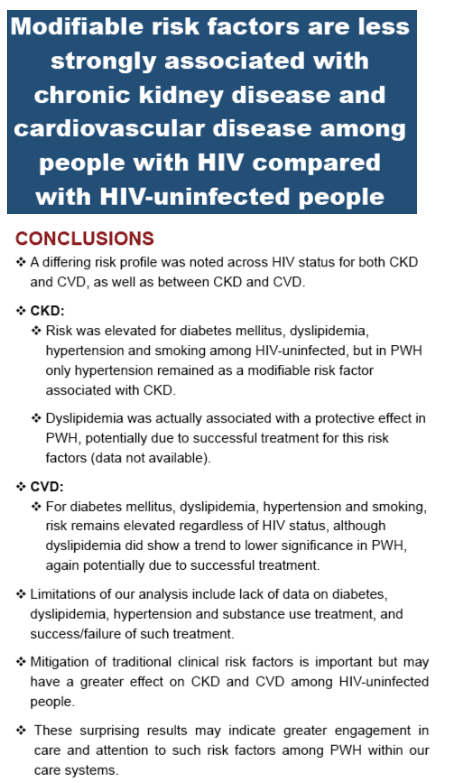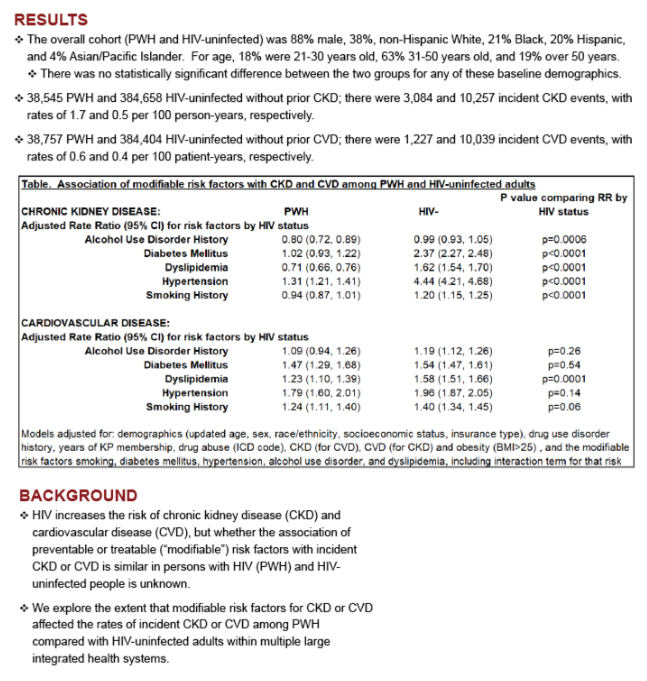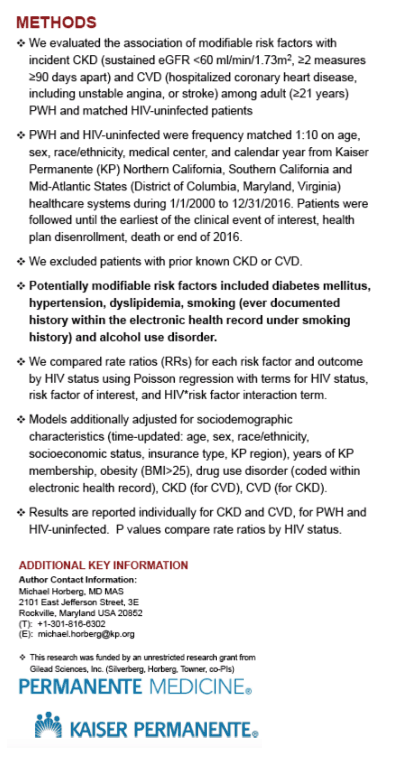 |
 |
 |
| |
Modifiable Risk Factors for Kidney and Heart
Disease Have Less Impact in HIV+ Than HIV-
|
| |
| |
CROI 2020, March 8-11, 2020, Boston
from Jules: still, rates of kidney disease & CVD are higher in HIV+, particularly in older HIV+ >65 although I have seen 2 studies finding HIV+ with good CD4 >500 & suppressed VL are not at greater risk for CVD, but I caution on this because subclinical CVD has been seen along with bad plaque (non-calcified plaque) in HIV+ who I believe are suppressed by Mass Gen Grinspoon group.
Mark Mascolini
Well-known risk factors for chronic kidney disease (CKD) and cardiovascular disease (CVD) led to those diseases more consistently in people without HIV than with HIV, according to a study of 423,000 people in the US Kaiser Permanente (KP) healthcare system [1]. KP researchers did not suggest that people with HIV and their clinicians ignore major risk factors for CKD and CVD. Instead, they surmised that strong attention to those risk factors by HIV-positive people may explain some of this study's findings.
The KP team set out to gauge the impact of modifiable (preventable or changeable) risk factors on development of CKD (sustained estimated glomerular filtration rate below 60 mL/min on at least 2 consecutive measures) or CVD (hospital admission for coronary heart disease, including unstable angina, or stroke) in people at least 21 years old. They matched each HIV-positive person in the KP healthcare system to 10 HIV-negative people for age, sex, race/ethnicity, medical center, and year. The study excluded people who already had CKD or CVD. The study period ran from January 2000 through December 2016.
The study looked at 5 well-established risk factors: diabetes, hypertension, abnormal lipids, smoking, and alcohol use disorder. The researchers used Poisson regression to compare rate ratios that would indicate the impact of the risk factor on CKD or CVD in people with or without HIV. These models considered HIV status, risk factor of interest, and HIV x risk factor interaction. The models also accounted for numerous sociodemographic factors, years of KP membership, obesity, drug use disorder, CKD (in the CVD analysis), and CVD (in the CKD analysis).
The HIV group did not differ significantly from the HIV-negative group in proportion of men (88% overall), whites (38%), blacks (21%), Hispanics (20%), Asian/Pacific Islanders (4%), or age (63% 31 to 51).
The CKD analysis included 38,545 people with HIV and 384,658 without HIV. During follow-up, there were 3084 CKD diagnoses in the HIV group and 10,257 in the HIV-negative group for rates of 1.7 and 0.5 per 100 person-years. All risk factors predicted CKD more strongly in HIV-negative people than in the HIV group. Having alcohol use disorder and abnormal lipids appeared to protect people with HIV from CKD. Only hypertension independently predicted CKD in people with HIV. All risk factors except alcohol disorder predicted CKD in people without HIV.
Chronic kidney disease, adjusted rate ratio (and 95% confidence interval [CI]) for impact of risk factor on development of CKD. A rate ratio below 1.00 suggests that the risk factor protects against CKD if both numbers in the 95% CI are also below 1.00. A rate ratio above 1.00 indicates that the risk factor makes CKD more likely if both numbers in the 95% CI are also above 1.00:
Alcohol disorder: HIV+ RR 0.80 (0.72-0.89), HIV- RR 0.99 (0.93-1.05), RR HIV+ vs HIV- P = 0.0006
Diabetes: HIV+ RR 1.02 (0.93-1.22), HIV- RR 2.37 (2.27-2.48), RR HIV+ vs HIV- P < 0.0001
Abnormal lipids: HIV+ RR 0.71 (0.66-0.76), HIV- RR 1.62 (1.54-1.70), RR HIV+ vs HIV- P < 0.0001
Hypertension: HIV+ RR 1.31 (1.21-1.41), HIV- RR 4.44 (4.21-4.68), RR HIV+ vs HIV- P < 0.0001
Smoking history: HIV+ RR 0.94 (0.87 to 1.01), HIV- RR 1.20 (1.15 to 1.25), RR HIV+ vs HIV- P < 0.0001
The CVD analysis involved 38,757 people with HIV and 384,404 without HIV. During follow-up these two groups had 1227 and 10,039 new diagnoses of CVD for rates of 0.6 and 0.4 per 100 person-years.
In the CVD analysis, abnormal lipids and smoking predicted heart disease more strongly in people without HIV than in those with HIV. In this analysis no risk factors appeared to protect people with HIV from CVD. Except for alcohol disorder, all risk factors independently predicted CVD in people with HIV. All five factors independently predicted CVD in people without HIV.
Cardiovascular disease, adjusted rate ratio (and 95% CI) for impact of risk factor on development of CVD. A rate ratio above 1.00 indicates that the risk factor makes CVD more likely if both numbers in the 95% CI are also above 1.00:
Alcohol disorder: HIV+ RR 1.09 (0.94-1.26), HIV- RR 1.19 (1.12-1.26), RR HIV+ vs HIV- P = 0.26
Diabetes: HIV+ RR 1.47 (1.29-1.68), HIV- RR 1.54 (1.47-1.61), RR HIV+ vs HIV- P = 0.54
Abnormal lipids: HIV+ RR 1.23 (1.10-1.39), HIV- RR 1.58 (1.51-1.66), RR HIV+ vs HIV- P = 0.0001
Hypertension: HIV+ RR 1.79 (1.60-2.01), HIV- RR 1.96 (1.87-2.05), RR HIV+ vs HIV- P = 0.14
Smoking history: HIV+ RR 1.24 (1.11-1.40), HIV- RR 1.40 (1.34-1.45), RR HIV+ vs HIV- P = 0.06
The researchers suggested that the apparent protective effect of abnormal lipids against CKD in people with HIV may reflect successful treatment of this problem. They do not speculate on reasons for the apparent protective effect of alcohol disorder on CKD. Perhaps people with identified alcohol problems received greater attention for potential complications like kidney disease. Overall, they proposed, "these surprising results may indicate greater engagement in care and attention to such risk factors among people with HIV within our care system."
The KP team stressed that preventing or controlling key kidney and heart risk factors remains critical to HIV care, but these risk factors may have a greater impact on CKD and CVD in some populations of people without HIV.
Reference
1. Horberg MA, Leyden W, Hechter RC, et al. Modifiable risk factors and incident CKD and CVD among HIV+ and HIV- patients. Conference on Retroviruses and Opportunistic Infections (CROI). March 8-11, 2020. Boston. Abstract 709.
Poster online at http://www.croiconference.org/sites/default/files/posters-2019/1430_2_Horberg_00709.pdf



|
| |
|
 |
 |
|
|